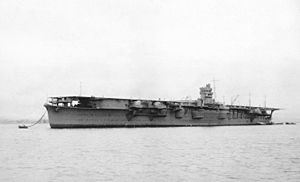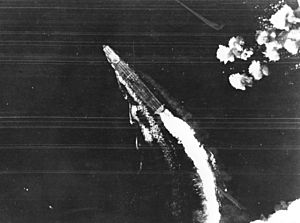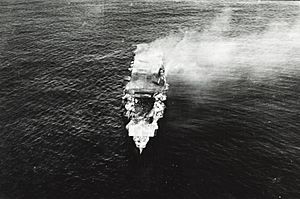Japanese aircraft carrier Hiryū facts for kids

Hiryū at anchor in Yokosuka, shortly after completion in 1939
|
|
Quick facts for kids Class overview |
|
|---|---|
| Operators: | |
| Preceded by: | Sōryū |
| Succeeded by: | Shōkaku class |
| Built: | 1936–1939 |
| In commission: | 1939–1942 |
| Completed: | 1 |
| Lost: | 1 |
| History | |
| Name | Hiryū |
| Namesake | Japanese: 飛龍 "Flying Dragon" |
| Builder | Yokosuka Naval Arsenal |
| Laid down | 8 July 1936 |
| Launched | 16 November 1937 |
| Commissioned | 5 July 1939 |
| Stricken | 25 September 1942 |
| Fate | Scuttled after the Battle of Midway, 5 June 1942 |
| General characteristics | |
| Type | Aircraft carrier |
| Displacement | |
| Length | 227.4 m (746 ft 1 in) (o/a) |
| Beam | 22.3 m (73 ft 2 in) |
| Draft | 7.8 m (25 ft 7 in) |
| Installed power |
|
| Propulsion | 4 × shafts; 4 × geared steam turbines |
| Speed | 34 knots (63 km/h; 39 mph) |
| Range | 10,330 nmi (19,130 km; 11,890 mi) at 18 knots (33 km/h; 21 mph) |
| Complement | 1,100 |
| Armament |
|
| Armor |
|
| Aircraft carried |
|
Hiryū (meaning "Flying Dragon" in Japanese) was an aircraft carrier built for the Imperial Japanese Navy (IJN) in the 1930s. She was a unique ship, based on an earlier design but improved. Hiryū played a big part in the Pacific War. Her planes helped invade French Indochina and attacked Pearl Harbor. She also fought in the Battle of Wake Island and helped conquer the Dutch East Indies. Later, her aircraft bombed Darwin, Australia, and sank British ships during the Indian Ocean Raid.
Hiryū then joined three other carriers in the Battle of Midway in June 1942. American planes badly damaged her. She was sunk the next day because she couldn't be saved. Losing Hiryū and the other carriers at Midway was a major defeat for Japan. It helped the Allies win the war in the Pacific.
Contents
Ship Design and Features
Hiryū was one of two large aircraft carriers planned in the 1930s. She was first designed to be a sister ship to Sōryū. However, her design was changed and made bigger. This happened after problems were found with other Japanese ships. They were too top-heavy or not strong enough.
Her front part was raised, and her body (hull) was made stronger. The ship also became wider and had more armor. This made her more stable and protected.
Size and Crew
Hiryū was 227.4 m (746 ft 1 in) long. She was 22.3 m (73 ft 2 in) wide and had a draft of 7.8 m (25 ft 7 in). She weighed about 17,600 tonnes (17,300 long tons) when empty. Her crew had 1,100 officers and sailors.
Engines and Speed
Hiryū had four powerful steam turbine engines. These engines used steam from eight large boilers. Together, they made 153,000 shaft horsepower (114,000 kW) of power. This made Hiryū very fast, reaching speeds of 34.3 knots (63.5 km/h; 39.5 mph). She was the fastest carrier in the world when she was built.
The ship could travel 10,330 nmi (19,130 km; 11,890 mi) at a speed of 18 knots (33 km/h; 21 mph). Her engine exhaust went out through two funnels. These funnels were on the right side of the ship and curved downwards.
Flight Deck and Hangar
The carrier's flight deck was 216.9 m (711 ft 7 in) long and 27 m (88 ft 7 in) wide. It hung over the ship's main structure at both ends. Hiryū was one of only two carriers with its island (control tower) on the left side. It was also placed further back on the ship.
The flight deck had nine wires to help planes land safely. These wires could stop an aircraft weighing up to 6,000 kg (13,000 lb). The flight deck was only 12.8 m (42 ft 0 in) above the water. This was kept low by making the hangars shorter.
Hiryū had two hangars for aircraft. The upper hangar was 171.3 by 18.3 m (562 by 60 ft) and about 4.6 m (15 ft 1 in) high. The lower hangar was 142.3 by 18.3 m (467 by 60 ft) and about 4.3 m (14 ft 1 in) high. Together, they had a total area of about 5,736 m2 (61,740 sq ft).
Planes moved between the hangars and the flight deck using three elevators. The front elevator was in the middle of the ship. The other two were on the right side. Hiryū could carry 64 aircraft, plus 9 spare planes.
Weapons
Hiryū had six twin-gun mounts for 12.7-centimeter (5 inch) guns. These guns could shoot at both ships and aircraft. They were placed on platforms sticking out from the ship's sides. These guns could hit targets up to 14,700 m (16,100 yd) away. They could also shoot down planes as high as 9,440 m (30,970 ft).
For closer defense, the ship had seven triple and five twin mounts of 25 mm anti-aircraft guns. These were the standard Japanese light anti-aircraft guns in World War II. However, they had problems hitting fast-moving targets. They also had small magazines, meaning they needed frequent reloading.
Armor Protection
Hiryū had a strong armor belt around its waterline. This belt was 150 mm (5.9 in) thick over the ammunition storage. It was 90 mm (3.5 in) thick over the engine rooms and fuel tanks. Inside, there was an extra wall to stop splinters. The ship's deck armor was 25 mm (0.98 in) thick over the engine rooms. It was 55 mm (2.2 in) thick over the ammunition and fuel tanks.
Building and Early Service
Hiryū was named "Flying Dragon" following Japanese traditions for aircraft carriers. She was built at the Yokosuka Naval Arsenal. Her construction started on 8 July 1936. She was launched on 16 November 1937 and officially joined the navy on 5 July 1939.
In September 1940, Hiryū's air group helped the Japanese invasion of French Indochina. In February 1941, she supported the blockade of Southern China. In April, she joined the First Air Fleet, also known as Kido Butai.
Key Battles and Operations
Attack on Pearl Harbor
In November 1941, Hiryū joined the Japanese fleet preparing to attack the U.S. Navy base at Pearl Harbor, Hawaii. On 26 November, Hiryū and five other carriers left Japan. They sailed across the Pacific to avoid being seen. Hiryū carried 21 Mitsubishi A6M Zero fighters, 18 Aichi D3A dive bombers, and 18 Nakajima B5N torpedo bombers.
On 7 December 1941, Hiryū and the other carriers launched two waves of aircraft. Her torpedo bombers attacked ships at Pearl Harbor. Some hit battleships, including the Arizona, which sank. Her fighters attacked airfields, destroying many American planes. Two of Hiryū's dive bombers were lost during the attack.
Wake Island and Dutch East Indies
After Pearl Harbor, Hiryū and Sōryū were sent to attack Wake Island. On 21 December, their planes attacked targets on the island. The next day, they launched more planes. Two American fighter planes tried to stop them but were shot down. The island's defenders surrendered the next day.
In January 1942, Hiryū went to the Dutch East Indies. Her planes attacked Allied positions on Ambon Island on 23 January. On 19 February, Hiryū's planes joined air strikes against Darwin, Australia. Her aircraft sank or damaged several ships in the port. They also destroyed American planes on the ground.
On 1 March 1942, Hiryū's dive bombers damaged the destroyer USS Edsall and sank the oil tanker USS Pecos. On 5 March, the carriers attacked Tjilatjep, setting the town on fire and sinking five small ships.
Indian Ocean Raid
On 26 March, Hiryū and four other carriers began a raid into the Indian Ocean. On 4 April, a British plane spotted them near Sri Lanka. Hiryū's fighters helped shoot it down. The next morning, her planes attacked Colombo. They shot down British torpedo bombers and fighters. The Japanese planes damaged port facilities.
Later that morning, British cruisers Cornwall and Dorsetshire were spotted. Hiryū launched 18 dive bombers. They helped sink both ships. On 9 April, Hiryū's planes attacked Trincomalee. They fought British fighters and bombed the port.
Later, a Japanese plane spotted the small aircraft carrier Hermes. Hiryū sent 18 dive bombers and 3 fighters to attack. They arrived too late to help sink Hermes, but they sank other ships. After these attacks, the fleet returned to Japan.
Battle of Midway

Japan's Admiral Isoroku Yamamoto wanted to destroy the American carrier threat. He planned to invade Midway Atoll, hoping to draw out U.S. carriers. However, the U.S. Navy had broken Japan's secret code. They knew the plan and prepared an ambush.
On 25 May 1942, Hiryū sailed with three other Japanese carriers for Midway. She carried 18 fighters, 18 dive bombers, and 18 torpedo bombers. On 4 June, Hiryū launched planes to attack Midway. Her planes suffered heavy losses from American fighters and anti-aircraft fire.
American planes from Midway then attacked the Japanese carriers. Hiryū's fighters helped defend the fleet. They shot down many American torpedo bombers and dive bombers. However, the American attacks kept the Japanese off balance.
At 10:20 AM, American dive bombers attacked the other three Japanese carriers. They set all of them on fire. Hiryū was the only Japanese carrier left undamaged. She quickly launched 18 dive bombers and 6 fighters to attack the American carrier Yorktown.
Hiryū's planes hit Yorktown three times, causing severe damage and fires. Believing Yorktown was sunk, Hiryū launched a second wave of 10 torpedo bombers and 6 fighters. These planes hit Yorktown again, knocking out her power. The crew was ordered to abandon ship.
However, American carriers Enterprise and Hornet launched their own planes. At 4:45 PM, Enterprise dive bombers found Hiryū. They hit her with four large bombs. These explosions started huge fires on Hiryū's hangar deck. The front part of her flight deck collapsed.

The fires on Hiryū could not be controlled. Her engines stopped at 9:23 PM. A major explosion rocked the ship at 11:58 PM. The order to abandon ship was given at 3:15 AM. Survivors were taken off by destroyers.
Admiral Tamon Yamaguchi and Captain Tomeo Kaku chose to stay on board. Hiryū was torpedoed by a Japanese destroyer at 5:10 AM to sink her. However, she was still afloat hours later. Around 7:00 AM, a Japanese plane saw Hiryū still floating. Some crew members who hadn't heard the order to abandon ship were still on board. They finally left the ship around 9:00 AM. Hiryū sank around 9:12 AM, taking 389 men with her.
The loss of Hiryū and the three other Japanese carriers at Midway was a huge defeat for Japan. It greatly helped the Allies win the war. To hide the defeat, Hiryū was not immediately removed from the navy's list. She was finally removed on 25 September 1942.
The Japanese Navy later planned to build many new carriers based on Hiryū's design. These were called the Unryū class. However, only three were finished before the war ended.
Images for kids
See also
 In Spanish: Hiryū (1939) para niños
In Spanish: Hiryū (1939) para niños



